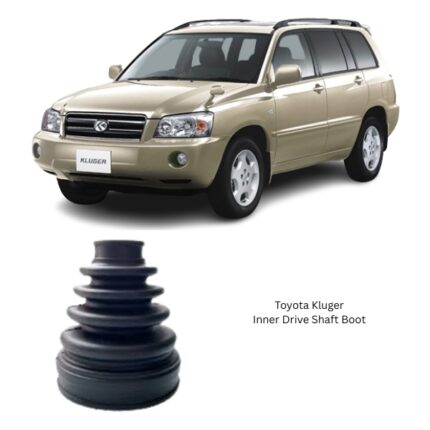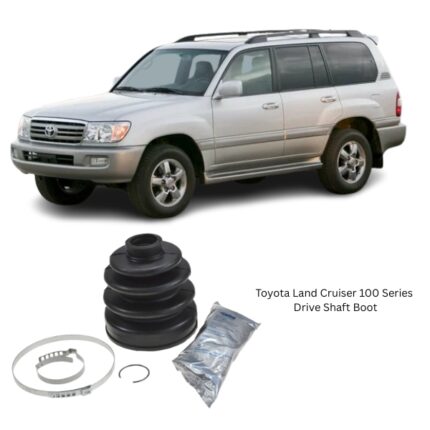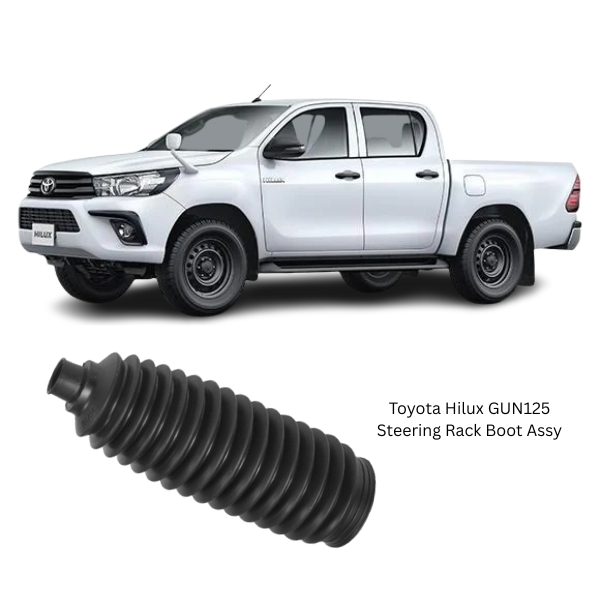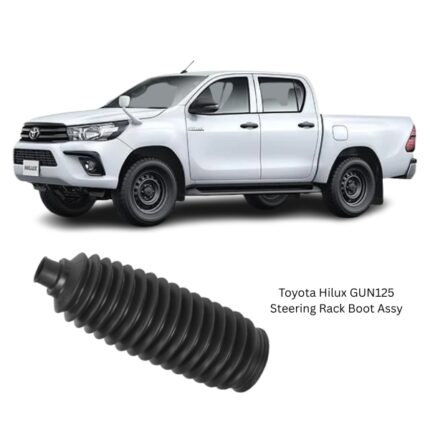Get Toyota Hilux GUN125 Steering Rack Boot Assy 45535-0K010 in Kenya
The Steering Rack Boot Assembly, also known as a steering rack gaiter or steering gear boot, is a critical component in the vehicle’s steering system. It may appear as a simple rubber sleeve, but it performs a crucial role in protecting the inner workings of the steering rack—especially the rack and pinion mechanism—from dirt, debris, moisture, and road contaminants.
Fitted at either end of the steering rack, this boot is designed to stretch, flex, and compress as the wheels turn and the suspension moves. It forms a tight seal over the steering rack ends and the tie rod, ensuring that the system operates smoothly without contamination or grease leakage.
Function and Purpose
The Steering Rack Boot Assy has one primary job: to protect the internal components of the steering gear while allowing full range of motion as the steering wheel is turned.
Key Functions:
-
Protective Barrier
Shields the steering rack from external contaminants such as water, dust, sand, and debris kicked up by the wheels. -
Seal for Lubrication
Helps retain the lubricants inside the steering rack assembly, ensuring smooth operation and reducing wear. -
Accommodates Movement
Expands and contracts as the rack shaft moves during steering, maintaining a sealed environment without restricting motion. -
Preserves Component Longevity
Prevents rust, abrasion, and premature failure of the rack and pinion gear, inner tie rod ends, and bushings.
Design and Construction
Though the design may appear basic, the Steering Rack Boot Assembly is engineered for flexibility, durability, and resistance to constant mechanical and environmental stress.
Structural Features:
-
Bellows Design
The central section consists of accordion-style folds or bellows that compress and stretch in harmony with the steering system’s movement. This design ensures flexibility without stretching the boot too thin. -
Clamping Collars
The ends of the boot feature thicker collars that fit snugly around the rack housing and inner tie rod. These ends are secured with metal clamps or zip ties to prevent dust or fluid entry.
Material Composition:
-
Neoprene Rubber
Widely used due to its excellent resistance to oil, road chemicals, ozone, and temperature variations. It provides long-lasting flexibility. -
Thermoplastic Elastomers (TPE)
Offer enhanced durability and resistance to cracking or deformation. Common in modern applications for lightweight and performance-optimized boots. -
Silicone (in high-performance variants)
More flexible and resistant to temperature extremes, though generally used in specialty or motorsport applications.
The materials are chosen not only for their mechanical properties but also for their ability to resist environmental aging.
Why It Matters
The Steering Rack Boot may not directly control the vehicle’s direction, but it protects the parts that do. The steering rack and inner tie rod ends are sensitive to contamination. Once moisture or dirt enters the system, it can lead to:
-
Corrosion of the rack shaft
-
Accelerated wear of gear teeth
-
Binding in the steering mechanism
-
Loss of steering smoothness or precision
-
Internal leakage in power steering systems (for hydraulic setups)
Thus, this small part plays a big role in preserving safe and efficient steering performance.
Symptoms of Wear or Failure
Since the Steering Rack Boot Assy is made of rubber or thermoplastics, it can degrade over time due to age, heat, road debris, or improper installation. Once damaged, it can no longer protect the rack from contamination.
Common Signs of a Damaged Rack Boot:
-
Cracks or Tears in the Boot
Visibly split or cracked rubber during inspection. -
Grease Leaks Around the Boot Area
Especially near the inner tie rods or rack housing—indicates a breached seal. -
Contaminants Inside the Boot
Signs of sand, water, or dirt inside the boot indicate failure and possible internal damage. -
Steering Noise or Stiffness
Without proper lubrication or with rusted components, steering effort may increase, or knocking sounds may develop. -
Power Steering Fluid Leakage (Hydraulic systems)
If fluid appears near the boot ends, the seals inside the rack may have been compromised due to boot failure. -
Loose or Missing Boot Clamps
Can lead to a loose fit and eventually boot displacement or detachment.
Timely detection and replacement can save the more expensive components like the rack-and-pinion assembly.
Installation and Replacement
Replacing a Steering Rack Boot Assy is a relatively straightforward task for trained technicians and is usually done when:
-
The boot is visibly worn or torn
-
During tie rod replacement
-
As preventive maintenance during suspension overhauls
General Steps:
-
Raise and Secure the Vehicle
Remove the wheel for access to the steering knuckle and inner tie rod. -
Detach Outer Tie Rod End
Remove it from the steering knuckle and unscrew from the inner tie rod. -
Cut or Remove Old Boot
If damaged, the old boot is typically cut off after removing the clamps. -
Clean and Inspect Components
Clean the rack shaft and tie rod area. Check for rust, wear, or grease contamination. -
Install New Boot
Slide the new boot onto the rack shaft and tie rod. Secure both ends with appropriate clamps or ties. -
Reinstall Components
Fit the outer tie rod end and reassemble the wheel. An alignment is usually recommended afterward.
Note: Always use manufacturer-recommended clamps or bands to ensure a tight, secure fit.
Maintenance and Inspection Tips
Even though the Steering Rack Boot is considered a passive component, regular inspection is advisable. During routine servicing:
-
Check for Flexibility
The boot should feel pliable, not brittle or stiff. -
Inspect for Grease
Any visible grease outside the boot is a red flag. -
Ensure Proper Clamping
Both ends should be securely fastened and show no signs of movement.
Frequent inspection is especially important for vehicles driven on dusty, muddy, or salted roads.
Benefits of Timely Replacement
-
Preserves Steering Gear Life
Prevents rust, wear, and contamination of sensitive rack components. -
Maintains Smooth Steering
Ensures that the steering remains light, accurate, and responsive. -
Prevents Costly Repairs
A low-cost component that protects the far more expensive rack-and-pinion system. -
Enhances Road Safety
Reduces the risk of steering stiffness, loss of feedback, or binding. -
Supports Suspension Health
Works in harmony with tie rods and bushings to ensure reliable front-end dynamics.
Follow us on Facebook for more parts.





Reviews
Clear filtersThere are no reviews yet.